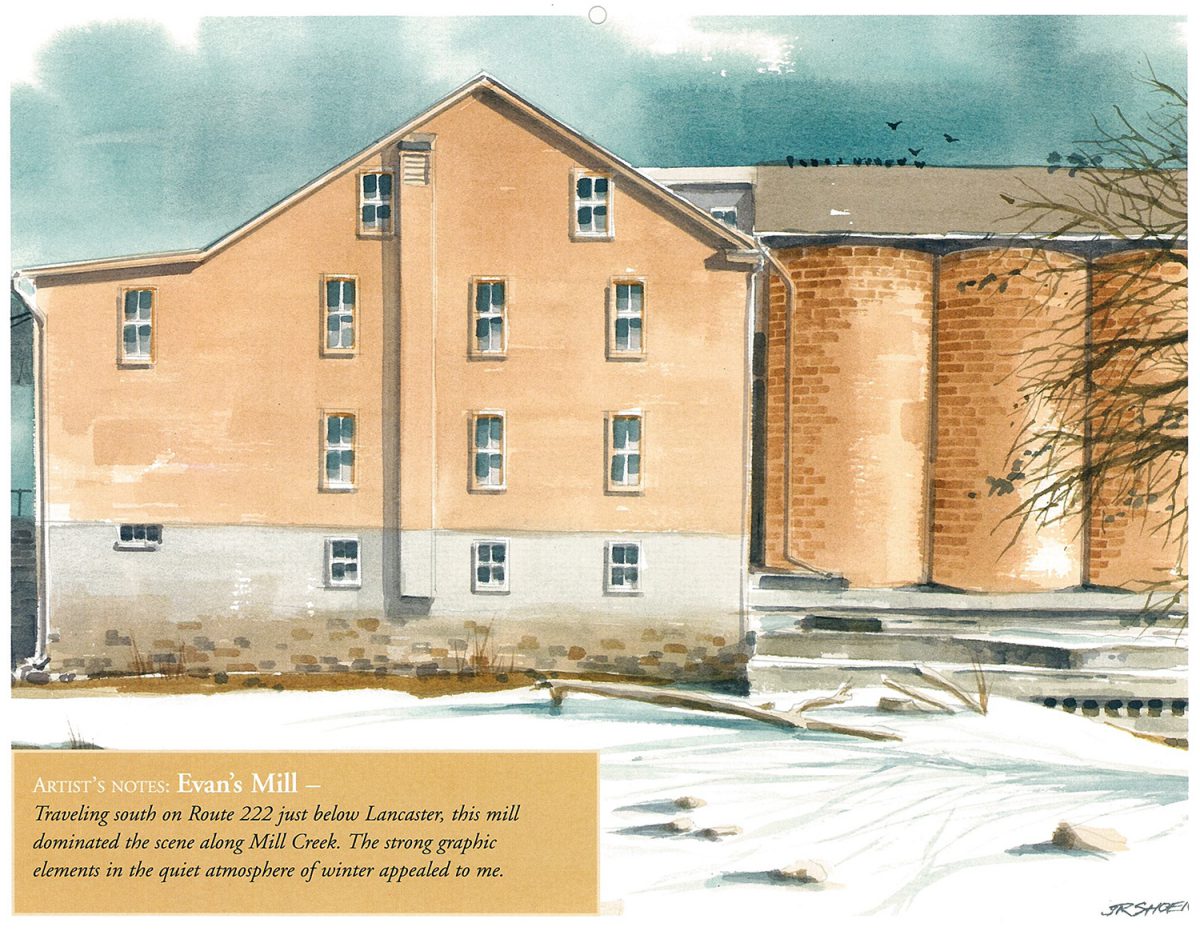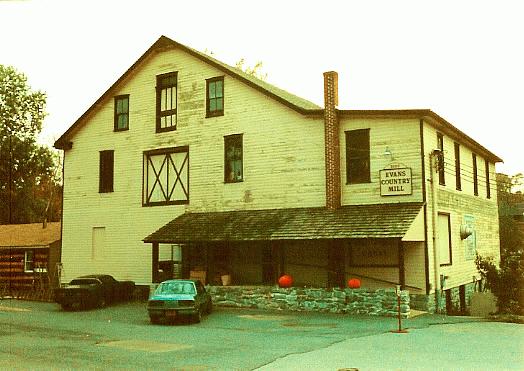Gone, But Not Forgotten: Evan’s Mill
Gone, But Not Forgotten: Evan’s Mill
In 2008, the Historic Preservation Trust of Lancaster County created a calendar series entitled “Gone, but not Forgotten” as a reminder of some things that aren’t here anymore. The Evan’s Mill was the featured image for September of that year and painted by J. Richard Shoemaker.
Artist’s Notes
Traveling south on Route 222 just below Lancaster, this mill dominated the scene along Mill Creek. The strong graphic elements in the quiet atmosphere of winter appealed to me.

Evan’s Mill south of Lancaster on Route 222 along Mill Creek.
A Brief History
John Kendrick (Kendig) operated a grist mill on this site as early as 1758. From 1758 through 1824, the mill was owned by a succession of Kenricks (Kendigs). John, John Jr., George, Henry, and George. The 2.5 story merchant mill under operation by Christian & Abraham Herr, burned and was rebuilt of brick by John & F. J. Herr either in 1845 or 1850 and they operated until selling to A. G. Groff in the mid-1870s.
Adam Groff had owned the mill for 12 years; when in 1889, the mill again burned down. The land and mill site was sold to Samuel Pugh, who built the new frame on a stone mill.
The siding of the mill was an old German tongue and groove and contained a European horizontal water wheel. The mill was purchased by Jay Evans in 1983; whereupon, he tore down the eight storage silos and restored the mill’s interior. The mill was renovated into a candy factory and restaurant, one-third & two-thirds respectively. The restaurant fizzled out so the entire mill was converted to candy production and sales in 1995. It is still the home of Evans Candy today.

This is the 1889 2.5 story frame mill, 60’X 80′ with stone first story merchant mill rebuilt by Samuel Pugh. From 1911 to 1980, the mill operated as the Lancaster Milling Company, featuring Daisy Flour from 1919 to 1980. This photo is dated 1992.
About the Artist
J. Richard Shoemaker, or Dick as he is better known, has incorporated both fine art and commercial endeavors into his lifestyle. He was president of Maclay & Shoemaker Graphics from 1970 to 2001 and is now engaged in freelance commercial illustration from his home studio in Lancaster. In his spare time, Dick paints watercolors of the surrounding countryside, frequently of scenes that have since disappeared. He also likes to paint views from his travels in the U.S. and England.
Born in Washington, D.C., on August 2, 1941, he has resided in Lancaster County since 1943. He became a commercial artist in York in 1962, worked for Studio K in Lancaster in 1963, and co-founded Maclay & Shoemaker Graphics in 1970.
It was during the early ’70s when Dick met well-known artist Bruce Johnson who got him interested in fine art, and from whom he took his first watercolor instruction. Dick became a signature member of the Pennsylvania Watercolor Society and has exhibited at Long’s Park, Mount Gretna, and Lititz Art Shows. He has also had a one-man show at Lebanon Valley College and a gallery show in Hershey.
Married, with a son, Dick enjoys playing trombone with the Malta Band of Lancaster and a game of tennis on the weekends. Model railroading is another favorite pastime that dovetails with his artwork, and he often scours nearby railroads for an impressive locomotive or scene to paint.
Historic Preservation Trust of Lancaster County
The Trust was established in 1966 to help “stem the rapid destruction of historic properties in Lancaster County.” Through the years, the Trust has been active in helping to preserve many historic properties in Lancaster County that contribute to their respective communities as unique places for people to live, work, and play.
Our equation for success has been working for over 50 years. Look around you and know that our advocacy and direct action have resulted in saving hundreds of historic structures and other sites throughout the county. The flip side is that not everything can and should be saved. The Trust continually faces this delicate balance and works closely with all parties involved to reach an equitable decision for all. Sadly, it sometimes takes an irreplaceable loss to a community before preservation moves higher on the priority list.





